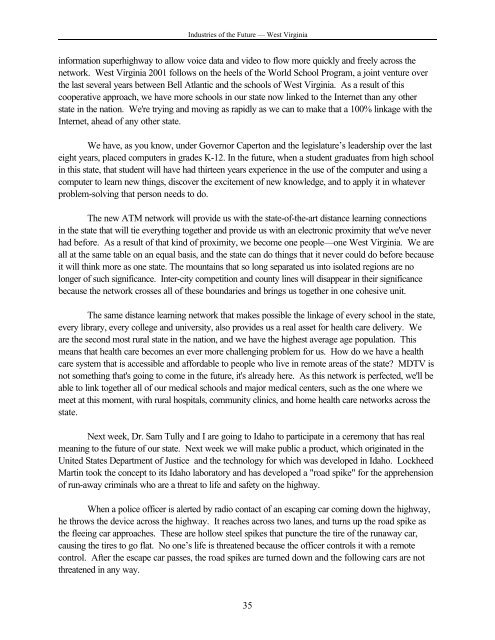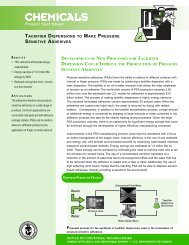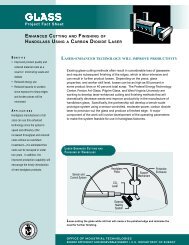PROCEEDINGS - Industries of the Future - West Virginia - West ...
PROCEEDINGS - Industries of the Future - West Virginia - West ...
PROCEEDINGS - Industries of the Future - West Virginia - West ...
You also want an ePaper? Increase the reach of your titles
YUMPU automatically turns print PDFs into web optimized ePapers that Google loves.
<strong>Industries</strong> <strong>of</strong> <strong>the</strong> <strong>Future</strong> — <strong>West</strong> <strong>Virginia</strong><br />
information superhighway to allow voice data and video to flow more quickly and freely across <strong>the</strong><br />
network. <strong>West</strong> <strong>Virginia</strong> 2001 follows on <strong>the</strong> heels <strong>of</strong> <strong>the</strong> World School Program, a joint venture over<br />
<strong>the</strong> last several years between Bell Atlantic and <strong>the</strong> schools <strong>of</strong> <strong>West</strong> <strong>Virginia</strong>. As a result <strong>of</strong> this<br />
cooperative approach, we have more schools in our state now linked to <strong>the</strong> Internet than any o<strong>the</strong>r<br />
state in <strong>the</strong> nation. We're trying and moving as rapidly as we can to make that a 100% linkage with <strong>the</strong><br />
Internet, ahead <strong>of</strong> any o<strong>the</strong>r state.<br />
We have, as you know, under Governor Caperton and <strong>the</strong> legislature’s leadership over <strong>the</strong> last<br />
eight years, placed computers in grades K-12. In <strong>the</strong> future, when a student graduates from high school<br />
in this state, that student will have had thirteen years experience in <strong>the</strong> use <strong>of</strong> <strong>the</strong> computer and using a<br />
computer to learn new things, discover <strong>the</strong> excitement <strong>of</strong> new knowledge, and to apply it in whatever<br />
problem-solving that person needs to do.<br />
The new ATM network will provide us with <strong>the</strong> state-<strong>of</strong>-<strong>the</strong>-art distance learning connections<br />
in <strong>the</strong> state that will tie everything toge<strong>the</strong>r and provide us with an electronic proximity that we've never<br />
had before. As a result <strong>of</strong> that kind <strong>of</strong> proximity, we become one people—one <strong>West</strong> <strong>Virginia</strong>. We are<br />
all at <strong>the</strong> same table on an equal basis, and <strong>the</strong> state can do things that it never could do before because<br />
it will think more as one state. The mountains that so long separated us into isolated regions are no<br />
longer <strong>of</strong> such significance. Inter-city competition and county lines will disappear in <strong>the</strong>ir significance<br />
because <strong>the</strong> network crosses all <strong>of</strong> <strong>the</strong>se boundaries and brings us toge<strong>the</strong>r in one cohesive unit.<br />
The same distance learning network that makes possible <strong>the</strong> linkage <strong>of</strong> every school in <strong>the</strong> state,<br />
every library, every college and university, also provides us a real asset for health care delivery. We<br />
are <strong>the</strong> second most rural state in <strong>the</strong> nation, and we have <strong>the</strong> highest average age population. This<br />
means that health care becomes an ever more challenging problem for us. How do we have a health<br />
care system that is accessible and affordable to people who live in remote areas <strong>of</strong> <strong>the</strong> state? MDTV is<br />
not something that's going to come in <strong>the</strong> future, it's already here. As this network is perfected, we'll be<br />
able to link toge<strong>the</strong>r all <strong>of</strong> our medical schools and major medical centers, such as <strong>the</strong> one where we<br />
meet at this moment, with rural hospitals, community clinics, and home health care networks across <strong>the</strong><br />
state.<br />
Next week, Dr. Sam Tully and I are going to Idaho to participate in a ceremony that has real<br />
meaning to <strong>the</strong> future <strong>of</strong> our state. Next week we will make public a product, which originated in <strong>the</strong><br />
United States Department <strong>of</strong> Justice and <strong>the</strong> technology for which was developed in Idaho. Lockheed<br />
Martin took <strong>the</strong> concept to its Idaho laboratory and has developed a "road spike" for <strong>the</strong> apprehension<br />
<strong>of</strong> run-away criminals who are a threat to life and safety on <strong>the</strong> highway.<br />
When a police <strong>of</strong>ficer is alerted by radio contact <strong>of</strong> an escaping car coming down <strong>the</strong> highway,<br />
he throws <strong>the</strong> device across <strong>the</strong> highway. It reaches across two lanes, and turns up <strong>the</strong> road spike as<br />
<strong>the</strong> fleeing car approaches. These are hollow steel spikes that puncture <strong>the</strong> tire <strong>of</strong> <strong>the</strong> runaway car,<br />
causing <strong>the</strong> tires to go flat. No one’s life is threatened because <strong>the</strong> <strong>of</strong>ficer controls it with a remote<br />
control. After <strong>the</strong> escape car passes, <strong>the</strong> road spikes are turned down and <strong>the</strong> following cars are not<br />
threatened in any way.<br />
35






